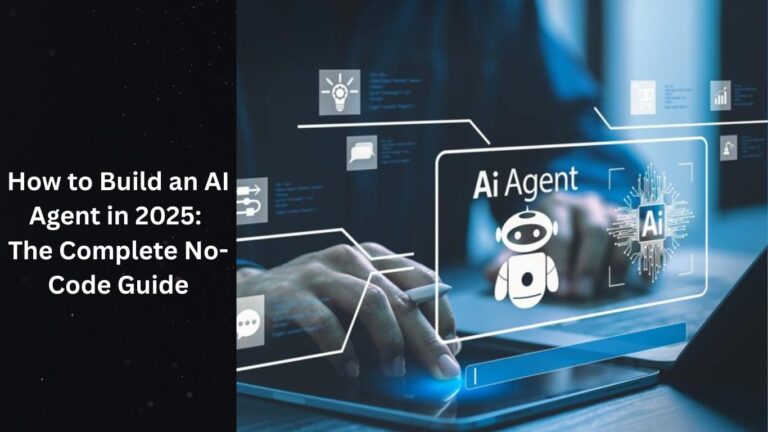The AI revolution is here, and AI agents are at the forefront of this transformation. In 2025, building sophisticated AI agents is no longer reserved for experienced programmers—visual platforms and no-code solutions have democratized agent development, making it accessible to anyone with an idea and determination.
This comprehensive guide will walk you through everything you need to know about building AI agents in 2025, from understanding the core concepts to deploying your first functional agent.
Understanding AI Agents in 2025

What Makes an AI Agent Different?
An AI agent is a system capable of reasoning, planning, and taking actions autonomously based on given information. Think of it as a digital employee that can think, remember, and execute complex tasks without constant supervision.
The key distinction lies in their dynamic nature. While traditional automation follows rigid, predefined workflows (A → B → C), AI agents demonstrate flexible intelligence. They can:
- Analyze situations in real-time
- Adapt their approach based on context
- Make decisions using reasoning capabilities
- Learn from interactions and improve over time
Also Read: Make a Film Using AI at Home
Real-World Example: The Weather Decision Agent
Consider asking an agent: “Should I bring an umbrella today?”
A traditional automation might simply return today’s weather. An AI agent, however, will:
- Recognise it needs weather data
- Call a weather API
- Analyse precipitation probability
- Consider your location and plans
- Provide a reasoned recommendation
This dynamic decision-making capability is what sets agents apart in 2025.
Also Read: Google I/O 2025: The AI Revolution
The Three Pillars of AI Agent Architecture
Every successful AI agent, regardless of complexity, is built upon three fundamental components:
The Brain (Large Language Model)


The LLM serves as the agent’s cognitive center, handling:
- Reasoning and planning capabilities
- Natural language understanding and generation
- Decision-making processes
- Context interpretation
Popular options in 2025 include:
- OpenAI’s GPT-4 and GPT-4 Mini
- Anthropic’s Claude Sonnet and Opus
- Google’s Gemini Pro
- Meta’s Llama models
Also Read: AI in Biotech: Bionl Review A Must Read!!!
Memory System


Memory enables agents to:
- Recall past interactions and context
- Build upon previous conversations
- Maintain state across sessions
- Access external knowledge bases
Memory types include:
- Short-term memory: Recent conversation context
- Long-term memory: Persistent knowledge and preferences
- External memory: Database and document repositories
Also Read: Top 10 Features Of Remaker AI
Tool Integration


Tools are the agent’s interface with the external world, categorized as:
Data Retrieval Tools:
- Web search capabilities
- Database queries
- Document analysis
- API data fetching
Action Tools:
- Email and messaging systems
- Calendar management
- File creation and editing
- Database updates
Orchestration Tools:
- Workflow triggers
- Sub-agent coordination
- Third-party service integration
Also Read: Best AI Tools for Stock Trading
Choosing Your Development Platform


Visual Development Platforms
In 2025, several no-code platforms have emerged as leaders for AI agent development:
NADN (Featured Platform)
- Visual node-based interface
- Extensive pre-built integrations
- Dedicated AI agent nodes
- Strong community support
Alternative Platforms:
- Zapier Central: Great for business automation
- Microsoft Power Platform: Enterprise-focused
- Make (formerly Integromat): Complex workflow support
- Bubble: Full application development
Also Read: Walbi Review – Is it really profitable?
Platform Selection Criteria
When choosing your platform, consider:
- Ease of use for your technical level
- Available integrations with your required services
- Pricing structure and scalability
- Community and support resources
- Security and compliance features
Also Read: 10 AI Tools to Build Websites
Step-by-Step Agent Building Process


Let’s build a practical AI agent that manages your daily trail running recommendations by checking your calendar, weather conditions, air quality, and suggesting optimal trails.
Phase 1: Project Foundation
Step 1: Initialise Your Project
- Create a new workflow in your chosen platform
- Name it descriptively (e.g., “Daily Trail Runner Assistant”)
- Set up proper organization and version control
Step 2: Configure the Trigger
- Add a Schedule Trigger for daily automation
- Set optimal timing (e.g., 7:00 AM daily)
- Configure timezone and frequency settings
Phase 2: Core Agent Setup
Step 3: Deploy the AI Agent Node
- Locate the AI/Agent section in your platform
- Add the dedicated AI agent node to your workflow
- Position it as the central processing unit
Step 4: Configure the Brain (LLM)
- Select your preferred LLM:
- GPT-4 Mini for cost-effectiveness
- Claude Sonnet for reasoning tasks
- Gemini Pro for Google ecosystem integration
- Set up API credentials:
- Generate API keys from your chosen provider
- Store credentials securely in your platform
- Test connection and verify access
- Configure model parameters:
- Temperature settings for creativity vs. consistency
- Token limits for response length
- Safety and content filtering options
Step 5: Implement Memory System
- Add memory component to your agent node
- Set context window length (recommended: 4,000-8,000 tokens)
- Configure memory persistence settings
- Test memory retention across interactions
Also Read: 10 Best AI Video Generators
Phase 3: Tool Integration
Step 6: Connect Essential Tools
Google Calendar Integration:
- Add Google Calendar tool node
- Authenticate with Google OAuth
- Specify target calendar
- Set permission scopes (read calendar events)
Weather Service Integration:
- Add OpenWeatherMap tool
- Obtain and configure API key
- Set location parameters (city, zip code, coordinates)
- Configure units (metric/imperial)
Data Storage Integration:
- Add Google Sheets tool for trail database
- Authenticate and set permissions
- Specify document and sheet names
- Configure read/write access as needed
Email Communication:
- Add the Gmail tool for notifications
- Set up authentication
- Configure recipient settings
- Enable LLM-generated content for the subject and body
Custom API Integration (Air Quality):
- Add an HTTP Request node for the AirNow.gov API
- Configure GET request parameters
- Set up the URL with proper query parameters
- Enable JSON response parsing
Step 7: Tool Configuration Best Practices
- Name tools descriptively for easy reference
- Test each integration individually before combining
- Document API endpoints and parameters for future reference
- Implement error handling for failed API calls
Phase 4: Agent Programming
Step 8: Craft the Master Prompt
A well-structured prompt is crucial for agent performance. Include these elements:
Role Definition:
You are a Personal Trail Running Assistant, designed to help optimize daily running experiences based on environmental conditions and personal preferences.
Task Specification:
Your primary task is to analyze daily calendar schedules, current weather conditions, air quality data, and available trail options to provide personalized trail running recommendations via email.
Tool Inventory:
Available tools:
- Google Calendar: Access daily schedule
- Weather API: Current conditions and forecasts
- Air Quality API: Real-time air quality index
- Trail Database: Personal trail preferences and details
- Email System: Send formatted recommendations
Decision Framework:
Decision-making process:
1. Check calendar for available time slots
2. Assess weather conditions (temperature, precipitation, wind)
3. Evaluate air quality safety levels
4. Match conditions with suitable trail characteristics
5. Generate personalized recommendation with reasoning
Output Requirements:
Provide recommendations in a clear, actionable email format including:
- Recommended trail with specific details
- Weather and air quality summary
- Optimal timing suggestions
- Safety considerations
- Alternative options if conditions are poor
Phase 5: Testing and Refinement
Step 9: Comprehensive Testing
- Unit testing: Test each tool individually
- Integration testing: Verify tool interactions
- End-to-end testing: Complete workflow execution
- Error scenario testing: Handle API failures gracefully
Step 10: Debugging Common Issues
- Authentication failures: Verify API keys and permissions
- Data format errors: Check JSON parsing and field mapping
- Rate limiting: Implement appropriate delays and retry logic
- Memory overflow: Optimize context window usage
Also Read: AI-Based Stock Trading in India: Benefits and Challenges
Advanced Concepts and Multi-Agent Systems


Single vs. Multi-Agent Architectures
Single Agent Approach:
- Simpler to build and maintain
- Sufficient for most use cases
- Easier debugging and troubleshooting
- Recommended starting point
Multi-Agent Systems:
- Manager/Supervisor Agent: Coordinates tasks and delegates
- Specialist Sub-Agents: Handle specific domains (research, communication, analysis)
- Workflow Orchestration: Manages inter-agent communication
Also Read: Best AI Tools for Students
When to Consider Multi-Agent Systems
- Complex business processes requiring specialization
- High-volume operations needing parallel processing
- Scenarios requiring different expertise domains
- Enterprise-level automation requirements
Implementation Strategy
- Start simple with single-agent solutions
- Identify bottlenecks and specialisation needs
- Gradually decompose complex tasks
- Implement proper orchestration and communication protocols
Also Read: Best AI Tools for Sales
Best Practices and Optimisation


Performance Optimization
1. Prompt Engineering Excellence
- Be specific and detailed in instructions
- Use examples to clarify expected behavior
- Structure prompts logically with clear sections
- Iterate and refine based on performance data
2. Efficient Tool Usage
- Minimize API calls through intelligent caching
- Batch operations when possible
- Implement retry logic with exponential backoff
- Monitor rate limits and usage quotas
3. Memory Management
- Optimize context windows for relevant information
- Implement memory pruning for long-running agents
- Use external storage for persistent data
- Balance memory vs. performance trade-offs
Also Read: Top 5 AI Video Generators: The future of Marketing
Security and Privacy Considerations
1. Data Protection
- Encrypt sensitive information in transit and at rest
- Implement access controls for tool permissions
- Regular security audits of integrations and workflows
- Compliance with regulations (GDPR, CCPA, etc.)
2. Authentication and Authorization
- Use OAuth 2.0 for service integrations
- Implement proper token management and rotation
- Scope permissions minimally for required functions
- Monitor access patterns for anomalies
Also Read – Best GPT-4 Plugins: Use ChatGPT like a pro
Scalability Planning
1. Architecture Design
- Modular component structure for easy updates
- Horizontal scaling capabilities for increased load
- Load balancing across multiple agent instances
- Database optimization for large datasets
2. Monitoring and Maintenance
- Comprehensive logging for troubleshooting
- Performance metrics tracking and alerting
- Regular updates for dependencies and integrations
- Backup and disaster recovery procedures
Also Read – 10 Ways to Earn Money Using AI
Conclusion
Building AI agents in 2025 represents an unprecedented opportunity to create intelligent, autonomous systems that can dramatically improve productivity and decision-making. The combination of powerful LLMs, sophisticated no-code platforms, and extensive tool ecosystems has made agent development accessible to creators at all technical levels. The future belongs to those who can effectively collaborate with AI agents. By following this comprehensive guide, you’re well-equipped to build powerful, reliable AI agents that can transform how you work and live in 2025 and beyond.
Frequently Asked Questions (FAQs)
What’s the difference between AI agents and traditional automation?
AI agents demonstrate flexible intelligence unlike traditional automation’s rigid workflows. They analyze situations in real-time, adapt approaches based on context, make reasoned decisions, and learn over time. For example, asking “Should I bring an umbrella?” prompts agents to gather weather data, analyze precipitation probability, consider your location and plans, then provide intelligent recommendations rather than just returning raw weather information.
Do I need programming experience to build AI agents in 2025?
No programming experience required. Visual platforms and no-code solutions have democratized AI agent development in 2025. Platforms like NADN offer visual node-based interfaces with pre-built integrations and dedicated AI agent nodes. Other options include Zapier Central, Microsoft Power Platform, and Make, providing drag-and-drop functionality, templates, and strong community support for anyone with determination.
What are the three essential components every AI agent needs?
Every AI agent requires three fundamental pillars: The Brain (Large Language Model) for reasoning, planning, and decision-making using models like GPT-4, Claude, or Gemini Pro; Memory System for recalling interactions, maintaining context, and accessing knowledge bases; and Tool Integration providing external interfaces including data retrieval tools, action tools for email/calendar management, and orchestration tools for workflows.
Should I start with a single agent or multi-agent system?
Always start with single-agent approach. Single agents are simpler to build, maintain, debug, and sufficient for most use cases. Multi-agent systems suit complex business processes requiring specialization, high-volume operations, or enterprise-level automation. Strategy: start simple, identify bottlenecks, gradually decompose complex tasks, then implement orchestration if needed for specialized domains.
What are the most important security and performance considerations?
Security priorities include encrypting sensitive data, implementing OAuth 2.0 for service integrations, using minimal permission scopes, and ensuring regulatory compliance. Performance optimization focuses on excellent prompt engineering with specific instructions, efficient tool usage through caching and batching, smart memory management with optimized context windows, and comprehensive monitoring with logging and performance metrics.



